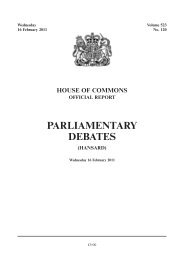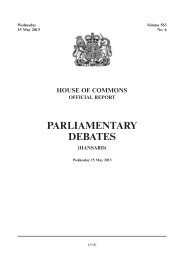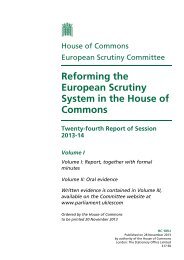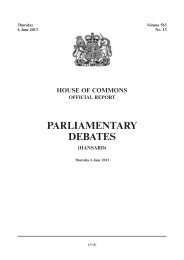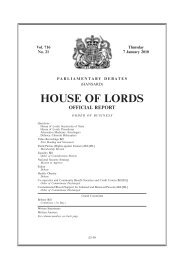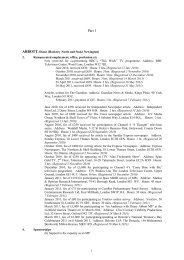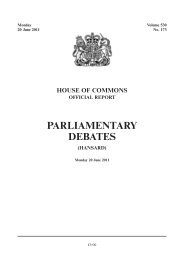Ticketing and Concessionary Travel on Public Transport - United ...
Ticketing and Concessionary Travel on Public Transport - United ...
Ticketing and Concessionary Travel on Public Transport - United ...
Create successful ePaper yourself
Turn your PDF publications into a flip-book with our unique Google optimized e-Paper software.
<strong>Transport</strong> Committee: Evidence Ev 67<br />
10. A major characteristic of the public transport networks in the urban areas of those other countries<br />
is c<strong>on</strong>sistently <str<strong>on</strong>g>and</str<strong>on</strong>g> carefully applied capital investment. It is the careful applicati<strong>on</strong> of that investment that<br />
really matters: we fall down <strong>on</strong> that in this area of technology, as we do with many areas of technology<br />
applied to public services. Thankfully, there is a move (eg Transformati<strong>on</strong>al Government, but perhaps more<br />
importantly a growing feeling that more <str<strong>on</strong>g>and</str<strong>on</strong>g> more civil servants are determined to do better) to be more<br />
careful in our use of investment m<strong>on</strong>ey, but I still believe that there are major lacunae that c<strong>on</strong>tinue to negate<br />
much of the possibilities for benefits.<br />
11. A final note: l<strong>on</strong>g distance coach services are currently operated entirely separately from other modes,<br />
with no sign of a move towards integrati<strong>on</strong> with those other modes, either of ticketing or, in the larger<br />
picture, of services.<br />
2. Does the Government have an adequate strategy for developing the integrati<strong>on</strong> of ticketing systems?<br />
12. Not any more; perhaps it never really did, as it may well have been that <strong>on</strong>ly a small number of civil<br />
servants (the key <strong>on</strong>e in DfT, Eric Samps<strong>on</strong>, has recently retired) really understood what ought to be d<strong>on</strong>e,<br />
although I submit that their c<strong>on</strong>cept of how it should be d<strong>on</strong>e has never been adequate: nowhere enough<br />
applicati<strong>on</strong> of the needs for thorough planning <str<strong>on</strong>g>and</str<strong>on</strong>g> for engineering discipline.<br />
13. Having been working recently with the trade associati<strong>on</strong> PSSG 2 <strong>on</strong> this topic, I do not know of any<br />
such strategy, despite the commitment to seamless travel as l<strong>on</strong>g ago as the 1988 Integrated <strong>Transport</strong> White<br />
Paper. Indeed, <strong>on</strong> heavy rail services ticketing has become more fragmented <str<strong>on</strong>g>and</str<strong>on</strong>g> increasingly diYcult for<br />
either customers or sellers to underst<str<strong>on</strong>g>and</str<strong>on</strong>g>. In particular, the selling by or for TOCs of tickets for use <strong>on</strong><br />
specific, timed rail services has been causing c<strong>on</strong>siderable distress, because ticket validity is not checked at<br />
the point of boarding: after departure, those who get <strong>on</strong> the wr<strong>on</strong>g train are charged the full open ticket<br />
fare by the Train Manager. The “Putting Passengers First” paper (see Annexes below) about bus services<br />
c<strong>on</strong>centrates <strong>on</strong>ly <strong>on</strong> proposals that attempt to improve punctuality <str<strong>on</strong>g>and</str<strong>on</strong>g> reliability (note that those are very<br />
technical terms in the industry <str<strong>on</strong>g>and</str<strong>on</strong>g> in regulatory circles, not necessarily having the meaning that the comm<strong>on</strong><br />
man or woman assign to them), to the exclusi<strong>on</strong> of all other benefits to the passenger. For l<strong>on</strong>g distance<br />
coach services there are no government strategies for integrati<strong>on</strong> of ticketing, either within that mode or<br />
between that mode <str<strong>on</strong>g>and</str<strong>on</strong>g> other modes.<br />
14. The strategy has to have two parallel streams:<br />
— commercial arrangements that benefit the traveller; <str<strong>on</strong>g>and</str<strong>on</strong>g><br />
— technology <str<strong>on</strong>g>and</str<strong>on</strong>g> management that enables eVective <str<strong>on</strong>g>and</str<strong>on</strong>g> eYcient delivery.<br />
15. Commercial arrangements have been severely restricted by the applicati<strong>on</strong> of competiti<strong>on</strong> law. There<br />
have been some improved guidelines recently, but I believe that that is nowhere near enough for the large<br />
commercial organisati<strong>on</strong>s currently operating most of the UK’s surface <str<strong>on</strong>g>and</str<strong>on</strong>g> sub-surface public transport.<br />
Despite guidelines from OFT, there is always the risk that massive commercial disrupti<strong>on</strong> will be caused if<br />
OFT changes its mind. An operator of public services needs a l<strong>on</strong>g term stable envir<strong>on</strong>ment, <str<strong>on</strong>g>and</str<strong>on</strong>g> so do the<br />
passengers. I have repeatedly used the phrase: “its no good accepting a guideline if the OFT can <strong>on</strong> a whim<br />
change it <str<strong>on</strong>g>and</str<strong>on</strong>g> come <str<strong>on</strong>g>and</str<strong>on</strong>g> hit you with a hammer”—they can stop what you do, tying up company executives<br />
in a l<strong>on</strong>g <str<strong>on</strong>g>and</str<strong>on</strong>g> expensive investigati<strong>on</strong>, <str<strong>on</strong>g>and</str<strong>on</strong>g> levying massive fines. Bus operating companies 3 in particular run<br />
lean <strong>on</strong> supervisory, admin <str<strong>on</strong>g>and</str<strong>on</strong>g> managerial staV, so that any investigati<strong>on</strong> is extremely disruptive.<br />
16. Technology has to be carefully planned <str<strong>on</strong>g>and</str<strong>on</strong>g> managed: its an engineering job. The TfL Oyster scheme<br />
in the end came good after a shaky early development period, but with its present technology it is not scalable<br />
much further than its present scope, <str<strong>on</strong>g>and</str<strong>on</strong>g> separate Oyster technology schemes in diVerent areas of the country<br />
cannot link up in the way that ITSO-compliant schemes are designed (<str<strong>on</strong>g>and</str<strong>on</strong>g> proven) to do—thus there is no<br />
interoperability between Oyster technology schemes. Oyster may, however, by adding ITSO technology, be<br />
capable of being ec<strong>on</strong>omically applied to other urban areas linked into nati<strong>on</strong>al interoperability 4 —but<br />
present tests indicate that, even with some optimisati<strong>on</strong>, performance of an ITSO compliant mode<br />
embedded in an Oyster scheme, in terms of throughputs through stati<strong>on</strong> gates, may not always meet the<br />
current c<strong>on</strong>tractual performance commitment to TfL.<br />
17. Currently it is unfortunately the case that ITSO Ltd <str<strong>on</strong>g>and</str<strong>on</strong>g> its developments are not managed as a Best<br />
Practice engineering company <str<strong>on</strong>g>and</str<strong>on</strong>g> project, <str<strong>on</strong>g>and</str<strong>on</strong>g> DfT, despite its significant funding for ITSO Ltd, has failed<br />
to trigger improvements. 5 The generic problem with a Company Limited by Guarantee without shares is<br />
that the Members have little opportunity to influence the incumbent management, <str<strong>on</strong>g>and</str<strong>on</strong>g> most of the Directors<br />
(generally operating as volunteers) find it extremely diYcult to influence a dominant cohort of managers (or<br />
even of Directors). By c<strong>on</strong>trast with ITSO Ltd, Network Rail works extremely well, through having an<br />
excellent team in charge, but in the l<strong>on</strong>g term such a corporate arrangement has some in-built risk.<br />
Nevertheless, Network Rail is successful in delivery terms <str<strong>on</strong>g>and</str<strong>on</strong>g> has gained the financial strength to source<br />
2 <strong>Public</strong> Sector Supplier Group. See their statement <strong>on</strong> this topic (submitted to Transcom <str<strong>on</strong>g>and</str<strong>on</strong>g> also available at www.pssg.biz)<br />
3 The big groups organise their bus operati<strong>on</strong>s into many regi<strong>on</strong>al operating companies.<br />
4 Eg in a competitive procurement process it might be that another metropolitan area purchases an ITSO compliant Oyster<br />
badged scheme.<br />
5 DfT does not have a Director <strong>on</strong> ITSO’s Board, <str<strong>on</strong>g>and</str<strong>on</strong>g> has to be careful not to be seen as a Shadow Director.



